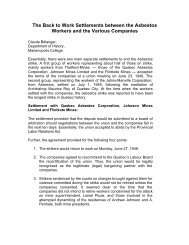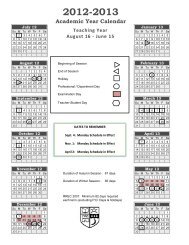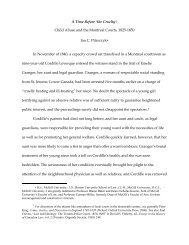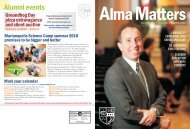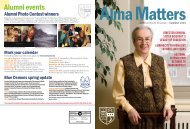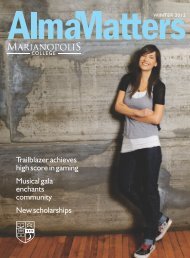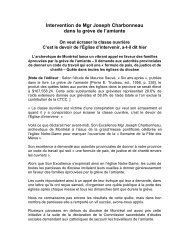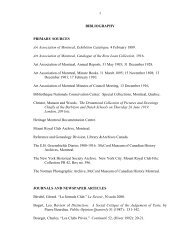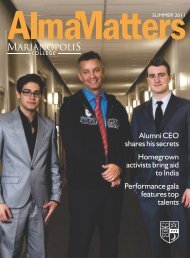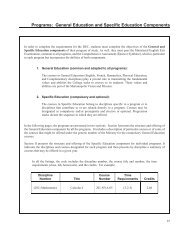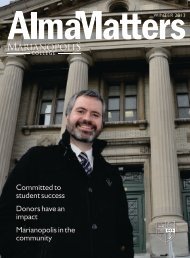Diploma requirements and course descriptions - Marianopolis
Diploma requirements and course descriptions - Marianopolis
Diploma requirements and course descriptions - Marianopolis
You also want an ePaper? Increase the reach of your titles
YUMPU automatically turns print PDFs into web optimized ePapers that Google loves.
SCIENCE (200.B0) DIPLOMA REQUIREMENTS (26 Courses)GENERAL EDUCATION COMPONENT (26-2/3 credits)58-2/3 CreditsMINISTERIAL REQUIREMENTS• 4 English• 3 Humanities• 3 Physical Education• 2 French• 2 Complementary9-1/3 credits6-1/3 credits3 credits4 credits4 credits• English Exit Examination• Comprehensive Assessment(épreuve synthèse): see note 1SPECIFIC EDUCATION COMPONENT (32 credits)Disciplines(32 credits chosen from a minimum of 4 <strong>and</strong> a maximum of 5 disciplines)Compulsory (24 credits): Elective (8 credits):• Biology - General Biology I 101-NYA-05• Chemistry - General Chemistry I 202-NYA-05- General Chemistry II 202-NYB-05• Mathematics - Calculus I 201-NYA-05- Calculus II 201-NYB-05- Linear Algebra I 201-NYC-05• Physics - Mechanics 203-NYA-05- Electricity & Magnetism 203-NYB-05- Waves, Light & Modern 203-NYC-05PhysicsA minimum of 8 credits chosen from <strong>course</strong>sin the following disciplines:• Biology: see note 2• Chemistry: see note 2• Computer Science: see note 3• Mathematics• Physics• 201-LCX-05 (Topics in Mathematics) is a <strong>Marianopolis</strong> requirement. Students who have taken an equivalent <strong>course</strong> atthe high-school level may seek an exemption from 201-LCX-05. Exemptions are granted by the Mathematics departmentat the registration preparation sessions.Notes: 1) Students must successfully complete an interdisciplinary (integrative) project to meet the <strong>requirements</strong>of the comprehensive assessment (épreuve synthèse) for a Science <strong>Diploma</strong>.2) 101-LCU-05 (General Biology II) <strong>and</strong> 202-LCU-05 (Organic Chemistry I) are required for all studentswishing to complete a Health Science profile.3) Students who choose Computer Science as an Elective Science discipline cannot take ComputerScience as a Complementary <strong>course</strong>.ENRICHED COURSES are offered in the Science program. These <strong>course</strong>s treat the material in greater depth thanwould be found in the regular sections of the <strong>course</strong>. Additional topics are included to provide a more comprehensivepreparation for future university studies in special areas such as engineering, architecture, physics, chemistry,mathematics <strong>and</strong> the life sciences. While <strong>course</strong> work in the enriched section is more challenging, final exams in mostenriched <strong>course</strong>s are consistent in level with those in the regular sections. An attestation certifying that students havetaken enriched <strong>course</strong>s is available from the Student Records Office that students may include it with their applicationto university.www.marianopolis.edu/science53
Science: Computer Science - Mathematicsscience, technology, commerce, <strong>and</strong>the arts. Computer scientists may beinvolved with circuit design, programming,problem solving, or projectplanning. Computer users mayproduce documents, performcommercial computations, or keeptrack of masses of information usingst<strong>and</strong>ard business packages. Usingspecialized software, they may solveequations or plot curves; they maydesign web pages, advertisements orindustrial parts.Computer Programming420-LCU-05 (3-2-3) 2.66 credits(Winter Term only)This <strong>course</strong> introduces students to aprogramming language, such as C++or Java, which is widely used byprofessional programmers <strong>and</strong> inuniversities. Material coveredincludes: st<strong>and</strong>ard programmingconstructs, introduction to structured<strong>and</strong> object-oriented programming,problem-solving techniques, programorganization <strong>and</strong> documentation,introduction to objects, classes,abstract data types. Emphasis is onproject development <strong>and</strong> organization,as well as introduction to generallyuseful programming techniques <strong>and</strong>to a variety of applications.The <strong>course</strong> is generally taught as alecture <strong>course</strong> with sessions in theComputer Lab. Students are expectedto complete programming projects ontheir own, in the Computer Lab <strong>and</strong>at home.Technical Drawing420-LCV-05 (3-2-3) 2.66 credits(Winter Term only)This <strong>course</strong> is an introduction to solidmodeling <strong>and</strong> industrial drafting, usinga computer-aided design packagesuch as Solid Edge. It is aimed atpotential engineers, architects, <strong>and</strong>anyone else needing to producetechnical drawings. Only basiccomputer literacy is assumed.The <strong>course</strong> covers elements ofcomputer-aided design, includingviews, projections, dimensioning,st<strong>and</strong>ard drawing elements <strong>and</strong> theirmeanings, 3-D modeling techniques,<strong>and</strong> working drawings. Studentsproduce designs <strong>and</strong> workingdrawings from given sketches <strong>and</strong>views, as well as designing objectson their own.The <strong>course</strong> involves some drawing byh<strong>and</strong>, as well as extensive h<strong>and</strong>s-onuse of the design software in theComputer Lab, both in class <strong>and</strong> forstudents working on their own.Programming Techniques <strong>and</strong>Applications420-LCW-MS (3-2-3) 2.66 creditsThis is a second-level programming<strong>course</strong>, covering parts of a universityleveldata structures <strong>course</strong>. Studentscompleting this <strong>course</strong> might obtainadvanced placement in a universityprogram in computer science or arelated engineering field.It is assumed that the student isfamiliar with the elements of theC++ or Java language up to <strong>and</strong>including arrays, user-definedfunctions, enumerated types, as wellas techniques of classical structuredprogramming. Students go beyondthis to cover recursion, dynamic dataallocation, linked lists, depth-firstsearch, trees, <strong>and</strong> some sortingtechniques.Students are expected to completeprogramming projects, working partlyduring scheduled lab time <strong>and</strong> partlyon their own. Each project includesprogram design as well as coding<strong>and</strong> testing.Mathematics (201)Mathematics is both a subject of studyin its own right <strong>and</strong> an indispensabletool in the study of all other branchesof Science.Reasonable proficiency in the theory<strong>and</strong> application of Mathematics isrequired for entry to all universityundergraduate programs in theHealth Sciences, Pure <strong>and</strong> AppliedSciences, Commerce <strong>and</strong> ComputerScience.Topics in Mathematics201-LCX-05 (3-2-3) 2.66 creditsPrerequisite:Sec. V Math TS (064506, 564506), orSec. V Math SN (065506, 565506)Students with an enriched mathbackground <strong>and</strong> who have taken anequivalent <strong>course</strong> at the high-schoollevel may seek an exemption from201-LCX-05. Exemptions are grantedindividually before registration.This <strong>course</strong> covers material whichprepares for <strong>and</strong> complements allscience mathematics <strong>course</strong>sincluding:201-NYA-05201-NYB-05201-NYC-05201-LCU-05201-LCV-05201-LCW-05201-LCY-05201-LCZ-MSContent: Topics in analytic geometry;topics in trigonometry; algebra ofcomplex numbers; polynomials overR <strong>and</strong> C; arithmetic <strong>and</strong> geometricprogressions; binomial theorem;mathematical induction; as timepermits, additional topics fromcombinatorics, probability. This<strong>course</strong> is also offered in enrichedformat.55
Science: Mathematics - PhysicsCalculus I201-NYA-05 (3-2-3) 2.66 creditsPrerequisite: 201-LCX-05 previouslyor concurrently for students notexempted from 201-LCX-05Content: Limits, continuity, derivativesby definition; techniques of differentiation;graphing; max-min problems;other applications. This <strong>course</strong> is alsooffered in enriched format in the fallterm.Calculus II201-NYB-05 (3-2-3) 2.66 creditsPrerequisite: 201-NYA-05Content: Definite <strong>and</strong> indefiniteintegrals, Fundamental Theorem ofCalculus; techniques of integration;indeterminate forms <strong>and</strong> improperintegrals; applications to area,volume, arc length; introductionto sequences <strong>and</strong> series of positiveterms. Additional topics: parametric,polar curves, approximate integrationas time permits. This <strong>course</strong> is alsooffered in enriched format in thewinter term.Calculus III201-LCU-05 (3-2-3) 2.66 creditsPrerequisites: 75% or better in201-NYB-05; 201-NYC-05 previouslyor concurrentlyContent: Infinite sequences <strong>and</strong> series;power series; vector functions <strong>and</strong>curves in parametric form; functionsof several variables; partial derivatives,chain rule; extrema, Lagrangemultipliers; multiple integration.Linear Algebra I201-NYC-05 (3-2-3) 2.66 creditsPrerequisite: 201-LCX-05 previouslyor concurrently for Science studentsnot exempted from 201-LCX-0556Content: Systems of linear equations;matrix algebra; determinants; vectorsin R n , geometry of lines <strong>and</strong> planes inR 3 ; R n as a vector space; subspaces,basis <strong>and</strong> dimension; as time permits,linear transformations of the plane.This <strong>course</strong> is also offered in enrichedformat in the fall term.Linear Algebra II201-LCV-05 (3-2-3) 2.66 credits(Winter term only)Prerequisites: 201-NYC-05previously; 201-NYB-05 at leastconcurrently with grades of 75% orbetter in previous math <strong>course</strong>sContent: Vector spaces, basis <strong>and</strong>dimension; inner product spaces;linear transformations <strong>and</strong> theirmatrix representations; eigenvalues<strong>and</strong> eigenvectors; application todiagonalization of quadratic forms<strong>and</strong> solution of linear differentialequations.Probability <strong>and</strong> Statistics201-LCW-05 (3-2-3) 2.66 creditsPrerequisite: 201-NYB-05Content: Descriptive statistics; measureof central tendency; probability;discrete <strong>and</strong> continuous distributionfunctions; mathematical expectation<strong>and</strong> variance; estimation <strong>and</strong> hypothesistesting; correlation <strong>and</strong> regressionanalysis; Chi-square Test.Finite Mathematics201-LCY-05 (3-2-3) 2.66 credits(Winter term only)Prerequisite: 201-NYC-05 previouslyor concurrentlyThis <strong>course</strong> will introduce the student tothe mathematics of finance, probability,statistics, linear programming <strong>and</strong>Markov chains with an emphasis onreal world applications.Differential Equations201-LCZ-MS (3-2-3) 2.66 credits(Winter term only)Prerequisite: 201-LCU-05 previouslyor concurrentlyAn introduction to differentialequations with emphasis on applicationsto physics <strong>and</strong> engineering.First order linear <strong>and</strong> nonlineardifferential equations, second orderlinear differential equations, vectorspaces <strong>and</strong> the general theory of nthorder linear equations; diagonalizationof matrices <strong>and</strong> systems of lineardifferential equations. Laplacetransform; nonlinear equations <strong>and</strong>stability. As time permits: numericalmethods, partial differential equations<strong>and</strong> Fourier series.Physics (203)The science of physics seeks touncover the fundamental nature of theuniverse at all scales. Physical lawspredict <strong>and</strong> explain the interaction ofthe particles <strong>and</strong> the forces weobserve. These laws reveal theunderlying simplicity <strong>and</strong> beauty ofnature – from the smallest subatomicpatterns to the largest cosmologicalstructures. Discoveries in physicsoften impact other sciences <strong>and</strong> canlead to applications in such diverseareas as biology, chemistry,medicine, astro-physics, geophysics,environmental science, <strong>and</strong>engineering.Each of the required <strong>course</strong>s (NYA,NYB, NYC) is usually offered in anenriched version as well. Enrichedsections provide additional stimulationto students who readily graspphysical concepts. This stimulationarises from a deeper treatment of theregular <strong>course</strong> material <strong>and</strong> from theinclusion of additional topics. The
enriched nature of the <strong>course</strong> isreflected in the <strong>course</strong> evaluation,<strong>and</strong> successful completion of anenriched section can be confirmed inan official letter that can be includedwith university applications.Mechanics203-NYA-05 (3-2-3) 2.66 creditsPrerequisites:Sec. V Physics (053504, 553504),or equivalent;Sec. V Math TS (064506, 564506), orSec. V Math SN (065506, 565506)Mechanics is the study of systems inmotion: how bodies move, <strong>and</strong> whatcauses them to move. In this <strong>course</strong>,the student learns the classical lawsgoverning translational <strong>and</strong> rotationalmotion, <strong>and</strong> their application to realsystems.Electricity <strong>and</strong> Magnetism203-NYB-05 (3-2-3) 2.66 creditsPrerequisites: 203-NYA-05 <strong>and</strong>201-NYB-05The diverse phenomena related toelectricity <strong>and</strong> magnetism (suchas electric power, circuits, staticelectricity <strong>and</strong> electromagnetism) areexplained using a simple frameworkof classical laws <strong>and</strong> fundamentalconcepts.Waves, Light <strong>and</strong> Modern Physics203-NYC-05 (3-2-3) 2.66 creditsPrerequisite: 203-NYA-05This <strong>course</strong> covers some basicproperties of waves <strong>and</strong> oscillations,properties of light (through a studyof geometrical <strong>and</strong> physical optics),<strong>and</strong> some introductory modernphysics concepts that are relevantto underst<strong>and</strong>ing the wave-particlenature of light. Elements of specialrelativity <strong>and</strong> radioactive decay areincluded.Digital Electronics203-LCV-05 (3-2-3) 2.66 credits(Winter Term only)Prerequisites:Sec. V Physics (053504, 553504),or equivalent;Sec. V Math TS (064506, 564506), orSec. V Math SN (065506,565506)In this <strong>course</strong>, the student obtainsa fundamental grasp of digitaltechnology <strong>and</strong> the logic underlyingall digital systems. Certain keycomponents are described: logicprocessors, memory devices <strong>and</strong>arithmetic units. The student alsobecomes proficient in using softwaresimulation <strong>and</strong> real integratedcircuits (chips) in creating their ownelectronic designs.Science: PhysicsAstrophysics203-LCW-05 (3-2-3) 2.66 credits(Winter Term only)Prerequisites: 203-NYA-05 <strong>and</strong>203-NYC-05 with 203-NYB-05 tobe taken at least concurrentlyThis <strong>course</strong> integrates astronomywith physics by introducing thebasic observational techniques <strong>and</strong>theoretical framework that make upastrophysics. This <strong>course</strong> covers somecelestial motions, gravity, <strong>and</strong> propertiesof electromagnetic radiation, byfocusing primarily on stars, galaxies<strong>and</strong> cosmology. The <strong>course</strong> usesplanetarium software <strong>and</strong> telescopesimulation software for lab work.There is no cumulative final exam inthis <strong>course</strong>.Topics in Physics203-LCZ-05 (3-2-3) 2.66 credits(Fall Term only)Prerequisite: 203-NYA-05While providing the student with asolid foundation in physics, timeconstraints prevent the presentationof a number of interesting <strong>and</strong>worthwhile topics in the three corecégep-level physics <strong>course</strong>s. In this<strong>course</strong>, at the instructor's discretion, avariety of topics not usually presentedor emphasized in the core <strong>course</strong>s willbe covered.57



